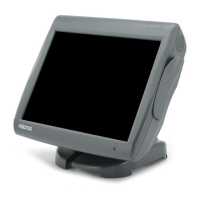26
Network Requirements and Planning
Oracle MICROS recommends that a qualified network professional plan, install, and
certify the network.
For reliability and ease of troubleshooting, all current Oracle MICROS products use
100/1000 BaseT networking topology based on twisted pair cabling. The benefits of
this include:
• Reduced Cable Costs
The installation of cable costs far more than the cable itself. The widely touted appeal
of 10/100/1000 BaseT is that is gives one the option of using existing telephone wiring,
thus saving installation costs. However, most sites do not have enough existing high-
quality twisted pair cable available to support a network installation, so more cable has
to be pulled anyway. The use of existing telephone wiring requires Oracle MICROS
approval.
• Troubleshoot Management, Fault Isolation, and Security
With the Ethernet star topology, problems are easy to troubleshoot. A single
workstation or printer is connected to a single port on the hub, switch or router,
allowing the behavior of each connection to be individually monitored. LED indicators
on each port provide immediate feedback on the link integrity and speed. A failure is
quickly isolated, and the remaining Ethernet devices continue to operate while the
problem is being addressed. Adding or moving devices is as simple as installing a wall
plate or plugging into a pre-wired connection at the switch or patch panel. Even in
small or low-cost installations, the single point of concentration, point-to-point
connectivity, and link status LEDs make diagnosing a problem on a 100/1000 BaseT
network much easier than checking an entire length of coax cable for a break.
• Structured Cabling Systems
• Elements of a Structured Cabling System
• Structured Cabling Examples
• Cable Types
• Cable Categories
• Mechanical and Electrical Considerations for Cable Installation
Structured Cabling Systems
When planning your network, Oracle MICROS recommends the Commercial Building
Telecommunications Cabling Standard TIA/EIA-568-C.
TIA/EIA-568-C defines standards for the implementation of structured cabling systems
for commercial buildings and between buildings in a campus environments. It is
composed of four sections.
The primary standard, TIA/EIA-568-C.1 defines the general requirements such as
cable types, distances, cable termination, and certification methods. -568-C.2 focuses
26-1

